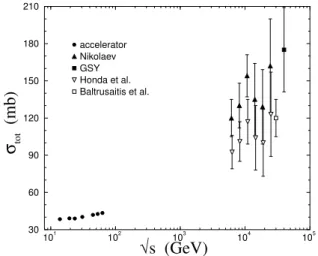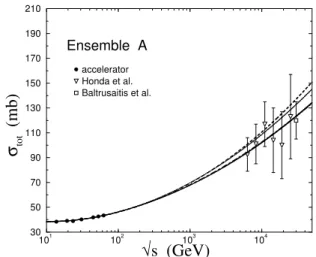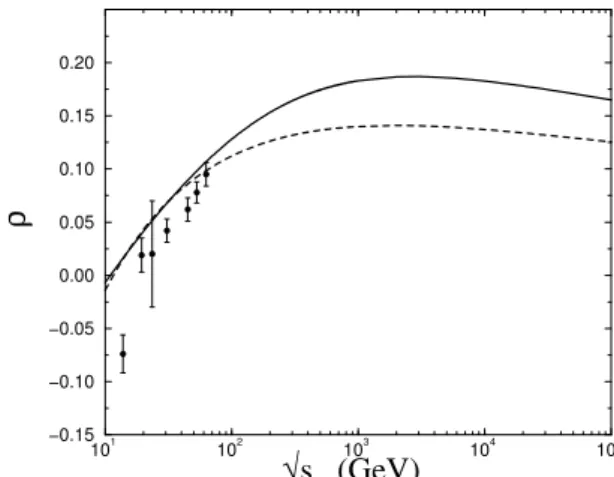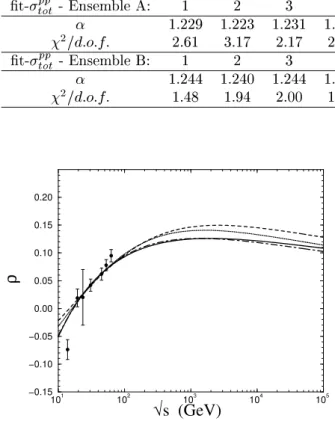High-Energy Proton-Proton Forward Sattering
and Derivative Analytiity Relations
R. F.
Avila 1
, E.G. S.Luna 2
, and M. J. Menon 2
1
InstitutodeMatematia, EstatstiaeComputa~aoCienta
UniversidadeEstadual deCampinas,UNICAMP
13083-970Campinas, SP,Brazil
2
Institutode FsiaGlebWataghin
UniversidadeEstadual deCampinas,UNICAMP
13083-970Campinas, SP,Brazil
Reeivedon15May,2001
We present the results of several parametrizations to two dierent ensemble of data onpp total
rosssetions( pp
tot
)atthehighestenter-of-massenergies(inludingosmi-rayinformation). The
resultsarestatistially onsistentwithtwodistintsenariosathighenergies. Fromoneensemble
thepreditionfortheLHC( p
s=14TeV)is pp
tot
=1135mbandfromtheother, pp
tot
=1407mb.
Fromeahparametrization,andmakinguseofderivativeanalytiityrelations(DAR),wedetermine
(s) (ratiobetweenthe forward realand imaginary partsof theelasti satteringamplitude). A
disussion ontheoptimization of theDARinterms ofa freeparameteris also presented. In all
asesgooddesriptions oftheexperimentaldataareobtained.
I Introdution
The totalrosssetion,
tot
, andthe parameter
(ra-tio of the real to imaginarypart of the forward
elas-ti sattering amplitude) are important quantities in
theinvestigationofelastihadron-hadronsatteringat
highenergies[1,2℄. Theyareexpressedintermsofthe
elastisatteringamplitude,F(s;t),bytheformulas,
tot
(s)=4ImF(s;t=0); (1)
(s)=
R eF(s;t=0)
ImF(s;t=0)
; (2)
where p
s isthe enter-of-mass energyand t the
four-momentum transfersquared.
For proton-proton (pp) ollisions, both quantities
havebeenextrated fromaelerator experimentsand
the results extendup to p
s 63 GeV. On the other
hand, pp
tot
mayalsobeinferredfromosmi-ray
exper-imentsatstill higherenergies, p
s10TeV.However,
these osmi-ray results are model-dependent, sine
theyareobtainedfromproton-airrosssetions[3℄and
thishasoriginateddierentresultsfor pp
tot
inthe
inter-val p
s=5 25TeV,whihexhibitareasonabledegree
ofdisrepany.
Severalmodelspresentextrapolationsatthe
osmi-rayregion and the observed disrepanies may be
a-ommodated by dierent models [4, 5, 6, 7, 8℄. As
weshallreall, presently,itisdiÆultto deidewhih
ouldbethe\orret"resultanditseemsthatthe
gen-eraltrendisto expet thenewdatafrom thenext
a-eleratorexperiments,theBNLRelativistiHeavyIon
Collider (RHIC), p
s 500 GeV [9℄ and the CERN
LargeHadronCollider(LHC), p
s14TeV[10℄.
However,atthisstage,weunderstandthatamodel
independent analysis of the experimental information
presentlyavailable,taking detailed aountofthe
dis-repaniesand itsonsequenes,maybring important
insightsonthesubjet. Thisistheentralpointweare
interestedin.
Inthisommuniation,werstinvestigatetwosets
of distint results for pp
tot
, at osmi-ray energies,
in a model independent way that also takes into
a-ount of the experimental data at the aelerator
re-gion( p
s>10GeV). Ineahasewetfour dierent
analytifuntions to eahensemble ofdata, using the
CERN-MINUITroutine[11℄. Nextwemakeuseofthe
one-subtratedderivativeanalytiityrelation(DAR)in
ordertoobtainanalytiparametrizationsforthe
pa-rameterasfuntionoftheenergy,frombothensembles
andfor all theparametrizations. Inthis investigation
westressthatthegeneral expressionoftheDARhasa
freeparameterandwepresentastudyonthepratial
Inallasesgood desriptionsoftheexperimentaldata
areobtained.
Thepaperisorganizedasfollows. InSe. II we
re-viewthe experimental informationon pp
tot
from
ael-eratorandosmi-rayexperimentsandreallthemain
stepsonnetingintegraland derivativeanalytiity
re-lations. The ts onerning pp
tot
and the results for
(s)arepresentedin Se. III.InSe. IVwedisussin
some detail allthe results obtained and present
om-parisonswithsomemodelpreditions. Theonlusions
andsomenal remarksaretheontentofSe. V.
II Experimental Information
and Analytial Approah
Here we rst review the experimental information
presently available on pp
tot
at the highest energies,
stressingthepuzzlesinvolvedattheosmi-rayregion.
We also reall some essential formulas onneting
in-tegralandderivativeanalytiity relationsandthe
or-responding derivativerelation between pp
tot
and (the
analytialapproah).
II.1 Experimental information on
pp total ross setions
Asmentionedbefore,inordertoanalyzethe
experi-mentalinformationpresentlyavailableon
tot
(s)forpp
interation atenergiesbeyond10GeV(highenergy
region), we must distinguish between aelerator and
osmi-rayinformation. In the later ase we follow a
disussionrstpresentedinRef. [4℄.
Conerning aelerators, data on pp
tot
from three
experiments at the CERN Interseting Storage Ring
(ISR),between23:5GeVand62:3GeV,wereritially
analyzedbyAmaldiandShubertandweshallonsider
herethenalmeanvaluesfrom theiranalysis[12℄. We
alsoinludetheresultsat13:8GeVand19:4GeV,
ob-tainedinFermilab[12℄.
Althoughotheraeleratordataexistinthisregion,
thissetissuitablefortheanalyzesweareinterestedin.
Fromonehand,thesedatarepresenttheorrettrend
ofpp ollisionsin theregion 10 60 GeVandallowa
statistial approah that inludes dierent osmi-ray
information(see whatfollows). Ontheother hand,as
willbedisussedinSe. IV,theyareadequatefor
om-parisonwithamodelthatpreditsafasterrisingof pp
tot
thangenerallyexpeted.
Dierentlyfromaeleratordata,osmi-ray
exper-imentalinformationon pp
tot
omesfromproton-airross
setions. Wereall that antiprotons are not expeted
to have any signiant role in these interations and
thereforethebulkofosmirayinformationon
hadron-nuleusrosssetionsdoesnotonernantiprotons.
Now, sine what is extrated in these experiments
istheproton-airrosssetion,thedeterminationofthe
pprosssetiondependsonnulearmodelassumptions
[3,4℄andthishasoriginatedsomepuzzles,asreviewed
in whatfollows.
The rst information on pp
tot
from osmi ray
ex-periments, at p
s = 30 TeV, was reported by
Baltru-saitisetal. in1984[13℄. Extensiveairshowersreorded
byFly'sEyedetetorallowedthedeterminationofthe
proton-air inelasti ross setion. Based on Glauber
theory,assumingaGaussianproleforthenuleusand
theproportionalitybetweentotalrosssetionandthe
slope parameter(geometrial saling), the authors
in-ferred[13℄
tot
=12015mb at p
s=30TeV: (3)
In1987,basedalso ondata fromFly's Eye
experi-ment, Gaisser,Sukhatmeand Yodh(GSY) introdued
thelimit pp
tot
130mb at p
s30TeVand,taking
aount of various proess in the Glauber theory and
additionalassumptions,estimated[14℄
pp
tot =175
+40
27
mb at p
s=40 TeV : (4)
Afterwards, extensive air shower data olleted in
the Akeno observatory allowed new estimates in the
range5 25TeV,reportedbyHondaetal. [15℄, whih
isinagreementwiththeresultreportedbyBaltrusaitis
et al. and in disagreement with the GSY result. In
partiular, extrapolations by Honda et al. indiated
[15℄
pp
tot
=13310mb at p
s=40TeV; (5)
whihisin agreementwith theresultreportedby
Bal-trusaitis et al. and in disagreement withthe GSY
re-sult. Inthesameyear,NikolaevlaimedthattheAkeno
resultshavebeenunderestimatedbyabout30mb[16℄
and, if we take this orretion into aount, the data
in the interval 5 25 TeV show agreement with the
early GSYresult. An importantpointis thefat that
theanalysisbyNikolaevseemsorret,hasneverbeen
ritiized and the sameis true for theGSY limitand
result.
Alltheseosmi-rayinformationsareshownin
Fig-ure 1, together with theaelerator data at lower
en-ergies. We stress that these experimental
informa-tion onern only pp and not pp interations. From
this Figure we learly see the disrepanies between
Honda/BaltrusaitisandGSY/Nikolaev.
Forthese reasons, in this paperweinvestigate the
behaviorofthetotalrosssetiontakingaountofthe
disrepaniesthatharaterizetheosmiray
informa-tion. Inordertodothat, weonsidertwo ensemblesof
data andexperimental information,with thefollowing
Ensemble A: aelerator data + Honda et al. +
Baltrusaitisetal.
EnsembleB:aeleratordata+Nikolaev+GSY
For ensemble A the referenesare [12, 13, 15℄ and
for ensemble B,[12, 14, 16℄. In Se. III we make use
of dierent parametrizationsto t thedata from eah
ensemble.
10
1
10
2
10
3
10
4
10
5
√
s (GeV)
30
60
90
120
150
180
210
σ
tot
(mb)
accelerator
Nikolaev
GSY
Honda et al.
Baltrusaitis et al.
Figure 1. Experimentalinformation onpptotal ross
se-tions: aeleratordataintheinterval13:8< p
s<62:5GeV
and osmi-rayresults inthe interval6:3 TeV< p
s <40
TeV.
II.2 Derivative analytiity
rela-tions and the parameter
Both
tot
(s)and(s) playaentral role in the
in-vestigation of high-energy hadron sattering. Due to
the onnetions between forward real and imaginary
partsofthesatteringamplitude,Eqs. (1)and(2),the
analytiity(dispersion) relationsonstitute asuitable,
modelindependent,approahforasimultaneousstudy
ofthese quantities.
Although integral dispersion relations have been
widelyusedinthestudyofhadronisattering,in
gen-eral, the analytial and/or numerial integrations are
notaneasytask. However,atsuÆientlyhighenergies,
thesmoothinrease of pp
tot
(Fig. 1) allowsto onnet
theintegralformwithaderivativeone,whihiseasier
tohandle. Thesoalledderivativeanalytiityrelations
(DAR) were introduedin theseventies[17℄ andsine
thenhavebeenritiallyinvestigated[18,19℄. Reently,
areursive approah wasdeveloped, aswellas
gener-alizationsto an arbitrary number of subtrations, for
bothrosseven andoddamplitudes,near theforward
diretion[20℄. Asintheintegralase,theonvergenes
maybeontrolledbysubtrationsandspeiformulas
areassoiatedwithrossevenandoddfuntions
(sat-tering amplitudes in the ase of partile-partile and
antipartile-partileinterations)[2℄.
Atthispointwestressone morethatweareonly
interestedinppsattering(wheredisrepanieshappen
in
tot
(s)) andnotpp. Besides, ourinvestigation
on-ernsthehighestenergies,haraterizedbythesmooth
inreaseof pp
tot
, nearly as a poweron lns. For these
reasonsin ouranalyzes wewill onsider only an even
amplitude, as the leading ontribution, and only one
subtration.
A detailed dedution onhowto obtainDAR from
integral relations may be found in referenes [17, 18,
19, 20℄. Here we onlyreview the main steps
onern-ingouraseofinterest,namely,onesubtrationandan
even amplitude. Webegin with thewellknown
one-subtratedintegraldispersionrelation(evenamplitude)
intheforwarddiretion(t=0)[2,21℄
R ef
+
(s)=K+ 2s
2
I; (6)
whereKR ef
+
(0)isthesubtrationonstantand
I =P Z +1 s0 ds 0 1 s 0 (s 02 s 2 ) Imf + (s 0 ): (7)
FollowingBronzan, Kane and Sukhatme [17℄, and
also[20℄, weonsider arealparameter sothat after
multiplyand dividebys
andintegratingbyparts we
obtain I = 1 2ss 0 ln s 0 s s 0 +s Imf + (s 0 )j 1 s 0 =s0 1 2s Z 1 s0 ds 0 s 0 1 ln s 0 s s 0 +s 1 s 0 + d ds 0 Imf + (s 0 )=s 0 : (8)
Taking aount of the high-energy region (s s
0
m
2
1 GeV 2
) and performing a hange of variable s 0
=
e
0
; s=e
;thelastequationmaybeputin theform
ExpandingImf + (s 0 )=s 0
in powersof 0
, after some manipulation and taking aount of thehigh energy
limit(s
0
!0,thatis, lns
0
! 1)weobtain
R ef
+
(s)=K+s 1 X n=0 d (n)
dlns (n) (Imf + (s)=s ) I n n! ; (10) whereI n
representstheintegralin thevariable 0 , I n = 1 Z +1 1 d 0 e ( 1)( 0 ) lnoth 1 2 j 0 j 1+ d d 0 ( 0 ) n : (11)
Wehaveassumedthattheseriesmaybeintegratedtermbyterm. Denoting 0
yandintegratingbyparts,
thisequationmaybeputin theform
I n = 1 lnoth 1 2 jyj e ( 1)y y n j +1 1 + 1 Z +1 1 dy e ( 1)y sinhy y n : (12)
A entralpointhereis thatthersttermontherighthandsideonvergestozeroonly for
0<<2: (13)
Inthisaseweonlyhavetheseondterm,whihanbeexpressedasareursiverelationintermsoftheparameter
[20℄: I n = d (n) I 0 d (n) ; (14)
andintegrationin theomplexplanegives
I 0 =tan 2 ( 1) : (15)
With this, weobtain anexpression onneting thereal part of anevenamplitude with thederivatives of the
imaginarypartatthesameenergy,namelytheDAR:
R ef + (s) s = K s +tan 2 1+ d
dlns Imf + (s) s : (16)
Theleadingtermin thetangentseriesreads
tan 2 ( 1) Imf + (s) s + 2 se 2 2 ( 1) d
dlns Imf + (s) s ; (17)
andmakinguseofthenormalization(k 2 s), f + (s) s
F(s;t=0); (18)
weobtainthegeneralresultforaforwardamplitude:
R eF(s;0)= K s +tan 2 ( 1)
ImF(s;0)+
+s 1 2 se 2 2 ( 1) d
dlns
ImF(s;0)
s 1
: (19)
Atlast,fromequation(1),weobtainthegeneralrelationonnetingand
tot : (s)= 4K s tot (s) +tan 2 ( 1) + 2 s 1 tot (s) se 2 2 ( 1) d
Thestandardformreferredto intheliteratureand
applied to hadronisatteringorrespondsto the
par-tiular hoie=1(butusually withoutthe
subtra-tiononstant)[1,2,22,23℄,whihweshallreferasthe
onventionalformoftheDAR:
(s)= 4K
s
tot (s)
+ 1
tot (s)
2 d
dlns (
tot
(s)): (21)
Inthenextsetionweuseboththeonventionaland
the general relations, in order to determine (s) from
dierentparametrizationsfor pp
tot
(s)and ensemblesof
data.
III Fits and results
Inthissetionwerstpresentthetstothetotalross
setionsforbothensemblesdenedinSe. II andthen
thepreditionsfor(s)obtainedbymeansofDAR.The
disussion onall theobtainedresultsis theontentof
Se. IV.
III.1 Fits to total ross setion
ForeahensembledenedinSe. II,wetthedata
with some standardand suitable parametrizations for
thetotalrosssetions:
fit1:
tot
=A+Blns+C(lns) 2
(22)
fit2:
tot
=A+Blns+C(lns) D
(23)
fit3:
tot
=A+Blns+C(lns) 2
+R s 1=2
(24)
fit4:
tot
=A+Blns+C(lns) D
+R s 1=2
(25)
where A; B; C ; D and Rarefreeparameters.
Thehoiefortheseparametrizationswasbasedon
thefollowingonsiderations. Firstly,sineFigure1isa
linear-log plot,weseethat at the highestenergiesthe
datasuggestaninreaseof pp
tot
asapolynomialonlns.
TheFroissart-Martinboundstatesthatthefastestrate
permissibleasymptotiallyfortherisingof pp
tot isln
2
s
[24℄. However,ithasbeenshownbytheUA4/2
Collab-orationthattstoppandppaeleratordataindiate
the power2:25 +0:35
0:31
,aresult referredto as a
\qualita-tivesaturationoftheFroissart-Martinbound"[25℄. For
these reasons,weonsiderpolynomialfuntionsonlns
with two possibilities for the power fator: the value
2, aordingto the asymptotial bound and asa free
parameter to be determined by the ts. Finally, the
powerfuntionons,Eqs. (24)and(25),representsthe
usualwaytotakeaountofdataatlowervaluesofthe
energy(520GeV)andanbeassoiatedwithRegge
phenomenology.
The ts were performed by using the
CERN-MINUITroutine [11℄ and the results for ensemblesA
and B are shown in Figs. 2 and 3, respetively. The
orrespondingvaluesofthefreeparametersandthe 2
perdegreeoffreedomaredisplayedinTable1and2for
ensembles A andB, respetively. Wedisuss all these
resultsin Se. IV.
10
1
10
2
10
3
10
4
√
s (GeV)
30
50
70
90
110
130
150
170
190
210
σ
tot
(mb)
accelerator
Honda et al.
Baltrusaitis et al.
Ensemble A
Figure2. Fitstopptotalrosssetiondatafromensemble
AthroughEqs. (22)-(25): t1(solid),t2(dotted),t3
(dot-dashed)andt4(dashed).
10
1
10
2
10
3
10
4
√
s (GeV)
30
50
70
90
110
130
150
170
190
210
σ
tot
(mb)
accelerator
GSY
Nikolaev
Ensemble B
Figure3. Fitstoppross setion fromEnsembleB.Same
Table1. ValuesoftheparametersinEquations(22)
(25) and the 2
per degree of freedom in eah t to
EnsembleA.
t: 1 2 3 4
A 45.78 42.64 38.74 33.67
B -3.315 -1.875 -1.868 -0.3201
C 0.3654 0.1220 0.2894 0.09465
D 2(xed) 2.312 2(xed) 2.288
R - - 21.52 31.40
2
11.7 15.4 9.8 9.9
d:o:f: 11 10 10 9
2
=d:o:f: 1.06 1.54 0.98 1.10
Table2. ValuesoftheparametersinEquations(22)
(25) and the 2
per degree of freedom in eah t to
EnsembleB.
t: 1 2 3 4
A 49.27 43.54 62.48 38.34
B -4.435 -1.846 -7.221 -0.8162
C 0.4534 0.05958 0.6050 0.03461
D 2(xed) 2.624 2(xed) 2.755
R - - -38.40 14.80
2
15.0 10.7 10.4 11.4
d:o:f: 11 10 10 9
2
=d:o:f: 1.36 1.07 1.04 1.27
III.2 Preditions for the
param-eter
Inthissetionwedeterminethe(s)behavior,
mak-ing use of the DAR and all the parametrizations for
pp
tot
obtainedinthelastsetion. Asommentedbefore
weare interestedin thepratialappliabilityof both
forms of the DAR, the general and the onventional
ones,Eq. (20)andEq. (21),respetively.
In priniple, the general expression (20) has two
\freeparameters", namelythesubtrationonstantK
and the parameter . Firstly, as a simpleexerise to
seetheeetoftheDAR,letusonsideroneofthets
to pp
tot
,forexamplet4,forbothensemblesAandB,
andalulate(s)throughtheonventionalexpression
andwithoutsubtrationonstant,whihmeanstaking
= 1and K =0 in Eq. (20), orK =0in Eq. (21)
(this orrespondsto theformula usuallyreferredto in
theliterature[1,2℄). TheresultsaredisplayedinFig. 4
together withtheexperimental data[26℄. Wesee that
althoughthepreditionsfrombothensemblesare
sim-ilar at the ISR energy region, both disagree with the
data.
Inwhat followsweinvestigate theinuene of the
above twofree parameters in the desription of these
data. In order to do that, we rst treat the
onven-tional formulawiththe subtrationonstantandthen
thegeneral formula,withoutsubtration onstantand
thefatorasfreeparameter.
Conventionalderivativedispersionrelation
With the parametrizations (22-25)for pp
tot
we
ob-tain analytial expressions for (s) by using the
on-ventional form of the DAR, Eq. (21). For eah
in-put parametrization the subtration onstant K is a
freeparameter,determinedbyt,throughthe
CERN-MINUITroutine,totheexperimental data[26℄.
Theresultsfromeahparametrizationandforboth
ensemblesare shown in Figures5and 6togetherwith
the experimental data. The valuesof the subtration
onstantand statistial information aboutthe tsare
displayedin Table3.
10
1
10
2
10
3
10
4
10
5
√
s (GeV)
−0.15
−0.10
−0.05
0.00
0.05
0.10
0.15
0.20
ρ
Figure4. Resultsfor(s), usingt4frombothensembles
A(dashed) andB(solid)and DARwith=1andK=0
inEq. (20)andexperimentaldata[26 ℄.
Table3. Valuesof thesubtration onstantfrom tsto(s)data andthe 2
for6degreeof freedom. Calulation
performedthorough Eq. (21)usingthefourtsto pp
tot
from ensemblesAandB.
t-pp
tot
-EnsembleA: 1 2 3 4
K -134.1 -135.6 -130.3 -129.6
2
=d:o:f: 0.82 0.63 0.97 0.63
t-pp
tot
-EnsembleB: 1 2 3 4
K -130.0 -134.4 -137.1 -132.0
2
10
1
10
2
10
3
10
4
10
5
√
s (GeV)
−0.15
−0.10
−0.05
0.00
0.05
0.10
0.15
0.20
ρ
Figure5. Resultsfor (s),throughtheonventional DAR,
Eq. (21), from tsto pp
tot
fromensembleAtogether with
theexperimentaldata. SamelegendasFig. 2.
10
1
10
2
10
3
10
4
10
5
√
s (GeV)
−0.15
−0.10
−0.05
0.00
0.05
0.10
0.15
0.20
ρ
Figure6. Resultsfor (s),throughtheonventional DAR,
Eq. (16), ts to pp
tot
from ensembleB, together withthe
experimentaldata. SamelegendasFig. 2.
Generalderivativeanalytiityrelation
As shown in some detail in Se. II.B, the general
result for the DAR depends on the free parameter .
It omes from theintegration by parts ofEq. (7)and
itisneessaryinordertoallowanitederivativeform
assoiatedwiththeintegralform. Inthissenseitseems
to playtheroleofaregularizationfator. Althoughin
nearlyallpratialusesoftheDARthevalue=1is
assumed, we have shown that its value is onstrained
to theinterval0<<2(seealsoreferenes[18, 19℄).
In partiular, in the ontext of a multiple diration
model, it was reently shown that the desription of
the experimental dataon ppelasti satteringmaybe
improved by taking as a free parameter [27℄. This
earlyresultinspiredustomakeuseofthegeneral
rela-tion(20)andtoinvestigatethepossibleeetofasa
freeparameter(some preliminary resultswere already
presented in Ref. [28℄). Tothis end we will nottake
aountofthesubtration onstantin thegeneral
for-mulafortheDAR,namelyK =0inEq. (20),sothat
weexpliitlyhave:
(s) = tan
2 ( 1)
+
+
2 se
2
2 ( 1)
1
tot (s)
d
tot (s)
dlns
+1
:
(26)
Withaxedparametrizationfor pp
tot
weantthe
experimental data on by letting to be a free
pa-rameterintheaboveequation,onemorebyusingthe
CERN-MINUIT.Theresultsfromallthe
parametriza-tionsfor pp
tot
with bothensemblesA andBareshown
inFigures7an8,respetively. Theorresponding
val-uesforandstatistialinformation aboutthets are
displayedinTable4.
Table 4. Values of the parameter from ts to (s)
data and the 2
for 6 degreeof freedom. Calulation
performed thorough Eq. (20) with K = 0 and using
thefourtsto pp
tot
fromensemblesAandB.
t-pp
tot
-EnsembleA: 1 2 3 4
1.229 1.223 1.231 1.230
2
=d:o:f: 2.61 3.17 2.17 2.20
t-pp
tot
-EnsembleB: 1 2 3 4
1.244 1.240 1.244 1.239
2
=d:o:f: 1.48 1.94 2.00 1.80
10
1
10
2
10
3
10
4
10
5
√
s (GeV)
−0.15
−0.10
−0.05
0.00
0.05
0.10
0.15
0.20
ρ
Figure7. Results for (s), throughthegeneral expression
oftheDAR,Eq.(20),withasfreeparameter,K=0and
tsto pp
10
1
10
2
10
3
10
4
10
5
√
s (GeV)
−0.15
−0.10
−0.05
0.00
0.05
0.10
0.15
0.20
ρ
Figure8. Resultsfor (s), throughthe generalexpression
oftheDAR,Eq. (20),withasfreeparameter,K=0and
tsto pp
tot
fromensembleB.
IV Disussion
The parametrizations for pp
tot
are theusual ones, but
the dierent ensembles, suggested by osmi-ray
re-sults, introdue novel behaviorsin the asymptoti
re-gion, as learly shown in Figs. 2 and 3. For
exam-ple, byalulatingthe averagevalueand thestandard
deviation from the four parametrizations we an
esti-mate pp
tot
(14 TeV ) =1135mb forensemble A and
pp
tot
(14 TeV ) =1407 mb for ensemble B.At lower
valuesoftheenergy,namely p
sintheregion10 100
GeV,thereisnosigniantdistintionbetweenthefour
parametrizations. In general, model preditions are
in agreement with the above result from ensemble A
[5,6,7℄,inluding thetby theUA4/2Collaboration
[25℄. To our knowledge, the only exeption (model)
that presents agreement with the result from
ensem-ble B is that of Ref. [4℄. This multiple diration
model is based on analyzes of pp elasti sattering in
theinterval13:8GeV p
s62:5GeV, thesameset
we used hereat the aeleratorregion. Extrapolation
to higher energies predited
tot
(16 TeV ) = 147 mb,
withoutestimatederrors. ReentlyPerez-Perazaet al.
improvedthismodelpreditionsdeterminingondent
error bands through a foreasting regression analysis
[29℄. Reading from Fig. 2of this referenewean
in-fer
tot
(16 TeV ) 14737 mb. Despite of the large
errorband (25%), evenin this aseitis learfrom
the quoted gure that the results favors ensemble B.
Froma\statistialpointofview"wemaysaythatthe
publishedresultsfrom modelsandtsshowagreement
with ensemble A. However, it should be stressed that
theosmi-rayestimationsintheensembleAwere
ob-tainedunder thehypothesisof thegeometrialsaling
[3℄,whihisviolatedevenat p
s500GeV.Moreover,
we should remember results from osmi-ray
experi-ments whih indiate the possibility of new
phenom-ena in pp ollisions at enter-of-mass energiesbeyond
500 GeV[30℄. As a diret onsequeneweshould
ex-petnewopenhannelsandthereforeafaster risingof
thepptotalrosssetionthanexpetedin the
extrap-olations from aelerator data. This seemsto be well
aommodatedbytheparametrizationswithensemble
B.
Conerningthedeterminationof(s)throughDAR,
werst showed thattheonventional expression
with-outsubtration onstant(=1andK =0)doesnot
reprodue the experimental data (Fig. 4). We
re-all that this expression has been referred to in the
literature [1, 2℄ and also used in the ontext of
phe-nomenologialmodels [22, 23℄. Taking aount of the
subtrationonstantK,thedataarewelldesribed,as
showninFigs. 5and6. FromTable3,
jKj130 137; (27)
depending on the t and ensemble for pp
tot
. As
ex-peted dierent ensembles orrespond to distint
be-haviorsatthe highestand asymptoti energies. As in
the aseof pp
tot
weanestimate an average valueand
standarddeviationfromthefourresultsinFigs. 5and
6: (14TeV )=0:1420:010with pp
tot
from ensemble
A and(14TeV )=0:1730:013fromensembleB.In
this asewean saythat theresultswith ensemble A
presentthebestagreementwiththeexperimentaldata
(Table3andFigs. 5and6). Wealsotestedthegeneral
expressionfortheDARbytaking K=0and letting
asafree tparameter. Theresultspresentedin Figs.
7 and 8show that the data are also satisfatorily
de-sribed, speially in the ase of pp
tot
from ensemble B
(omparewith Fig. 4, theaseof xed=1). From
Table4,
1:22 1:24; (28)
dependingalsoonthet andensemblefor pp
tot
. Inall
theseasestheondition(13)isveried.
V Conlusions and nal remarks
In this ommuniation we investigated two ensembles
of experimental information on pptotal ross setions
andusedfourdierentparametrizationstotthedata,
asfuntionoftheenergy. Ineahaseweobtained
pre-ditions for (s) making use of both the onventional
andthegeneral expressionsforthederivative
analyti-ityrelations.
Ourrstmainonlusionisthatexperimental
infor-mationpresentlyavailableonpptotalrosssetions
in-diatestwopossibledierentsenariosforthehadroni
interations at the highest energies. The fast rise of
pp
tot
from the analysis of ensemble B is orroborated
indiation of new phenomena from emulsion hamber
experiments[30℄. Althoughinthis workweonlypoint
out for this possibility, new information oming from
RHIC and LHC shall ertaintly larify this subjet.
In this sense, our results may be viewed as a kind
of warningagainstsomepossiblepreipitated
assump-tions,namely,thatextrapolationsfromaeleratordata
whihshowagreementwiththeosmi-rayestimations
inensembleAouldbethenalanswertothequestion.
Aseond novelresultfrom thismodelindependent
analysiswastoshowthepratialappliabilityofboth
the onventional and the general expressions for the
derivative analytiity relations at suÆiently high
en-ergies. In the onventional ase, = 1, letting the
onstant K as free parameter, the desription of the
experimental dataisquitegood. Ontheotherhand,
taking K =0and letting as free t parameter, the
results may be onsidered satisfatory. In both ases
the preditions at the highest energies are pratially
thesame(ompareFigs. 5and7andalsoFigs. 6and
and 8) and the dierenesat this energyregion ome
obviouslyfromthedierentensemblesfor pp
tot
. Our
ap-proahwastoonsider thetwopossibilitiesseparately
(K 6=0or 6=1), sothat weouldinfer theintervals
of possiblevariations, Eqs. (27)and (28).
Simultane-ous analysis with both possibilities shall improve the
desriptionof(s)andthis isourseond main
onlu-sion.
In this ommuniation we treatedonly pp
intera-tions, sine the osmi-ray informations onern only
this ase. We arepresently investigating theinlusion
ofantiproton-protondataintheanalysisthrough
ade-quateonsiderationsonrossingsymmetry.
WearegratefultoFapespfornanialsupportand
J.Montanhaforreadingthemanusript. M.J.M.isalso
thankfultoN.N.Nikolaevfordisussions,V.Ezhelafor
orrespondeneandCNPqfornanialsupport.
Referenes
[1℄ G.Matthiae,Rep.Prog.Phys.57,743(1994).
[2℄ M.M.BlokandR.N.Cahn,Rev.Mod.Phys.57,563
(1985).
[3℄ R.Engel,T.K.Gaisser,P.Lipari,andT.Stanev,Phys.
Rev.D58,014019(1998).
[4℄ A.F.MartiniandM.J.Menon,Phys.Rev.D56,4338
(1997).
[5℄ A. Donnahie and P. V. Landsho, Z. Phys. C 2, 55
(1979);Phys.Lett.B387,637(1996).
[6℄ P.Desgrolard,M. GionandE.Predazzi,Z. Phys.63,
241(1994).
[7℄ C.Bourrely,J.SoerandT.T.Wu,Nul.Phys.B247,
15(1984);Z.Phys.C37,369(1988).
[8℄ M.M.Blok,F.Halzen,T.Stanev,Phys.Rev.Lett.83,
4926(1999).
[9℄ The PP2PP (R2) Collaboration, BNL,
www.rhi.bnl.gov.
[10℄ The TOTEM Collaboration, Tehnial proposal,
CERN/LHCC99-7,(1999).
[11℄ F.James, MINUIT- Funtion Minimizationand
Er-rorAnalysis-RefereneManual,Version94.1,CERN
-D506(1994).
[12℄ Aelerator data on pp
tot
(the numbers between the
squaredbraketsindiate the enter-of-mass energyin
GeV):A.S. Carrol et al., Phys. Lett. B61, 303(1976)
[13.8℄; A.S. Carrol et al., Phys.Lett. B80, 423(1979)
[19.4℄;U.AmaldiandK.R.Shubert,Nul.Phys.B166,
301(1980)[23.5,30.7,44.7,52.8,62.5℄.
[13℄ R. M. Baltrusaitis et al., Phys Rev. Lett. 52, 1380
(1984).
[14℄ T.K. Gaisser, U.P. Sukhatme, and G.B. Yodh, Phys.
Rev.D36,1350(1987).
[15℄ H. Honda et al. (Akeno Collaboration), Phys. Rev.
Lett.70,525(1993).
[16℄ N.N.Nikolaev,Phys.Rev.D48,R1904(1993).
[17℄ N.V. Gribov and A.A. Migdal, Sov J.Nul. Phys.8,
583(1969);J.B.Bronzan, ArgonneSymposiumon the
Pomeron, ANL/HEP 7327 (1973) 33; J. D. Jakson,
1973 Sottish Summer Shool, LBL-2079 (1973) 39; J.
B.Brozan,G.L.Kane,andU.P.Sukhatme,Phys.Lett.
B49,272(1974);K.KangandB.Niolesu,Phys.Rev.
D11,2461(1975).
[18℄ G.K. Eihmannand J. Dronkers, Phys. Lett. B 52,
428(1974);J.HeidrihandE.Kazes,LetterealNuovo
Cimento12,365(1975);A.BujakandO.Dumbrajs,J.
Phys.G:Nul.Phys.12,L129(1976).
[19℄ J.Fisherand P. Kolar, Phys.Lett. B64,45 (1976);
Phys. Rev.D 17, 2168 (1978); Czeh. J. Phys.B 37,
297(1987);P.KolarandJ.Fisher,J.Math.Phys.25,
2538(1984).
[20℄ M.J.Menon,A.E.Motter,andB.M.Pimentel,Phys.
Lett.B451,207(1999);in1997-XVIIIBrazilian
Na-tionalMeeting onPartiles andFields,editedbyO.J.
P.
Ebolietal.(SBF,S~aoPaulo,1998)pp.548-552.
[21℄ F.W.Byron,R.W.Fuller,MathematisofClassialand
QuantumPhysis,(Dover,1992),Chap.6.
[22℄ U.Sukhatmeetal.,Phys.Rev.D12,3431(1975); V.
Barger, J.Luthie andR. J.N. Phillips, Nul.Phys.B
88,237(1975).
[23℄ M.Kawasaki, T.Maehara, M. Yonezawa, Phys.Lett.
B348,623(1995).
[24℄ M.Froissart,Phys.Rev.123,1053(1961);A.Martin,
andF.Cheung,Analyti Properties andBounds of the
Sattering Amplitude, (Gordon and Beah, New York,
1970).
[25℄ C.Augieretal.(UA4/2Collaboration),Phys.Lett.B
315,503(1993).
[26℄ Experimentaldataon(s) (thenumbersbetween the
squaredbraketsindiatethemenergyinGeV):L. A.
Fajardoetal.Phys.Rev.D24,46(1981)[13.8and19.4℄;
U.AmaldiandK.R.Shubert,Nul.Phys.B166, 301
[27℄ A.F. Martini, M.J. Menon, J.T.S. Paes e M.J. Silva
Neto,Phys.Rev.D59,116006(1999).
[28℄ R.F.
Avila,E.G.S.Luna,andM.J.Menon,inPro.
XXIBrazilianNationalMeetingonPartilesandFields,
S~aoLoureno,Brazil, 23-27Otober,2000(inpress).
[29℄ J.Perez-Perazaetal.,hep-ph/0011167(2000).
[30℄ Chaaltaya and Pamir Collaboration, Nul. Phys. B
370,365(1992);S.L. C.Barroso etal.,Nul.Phys.B




